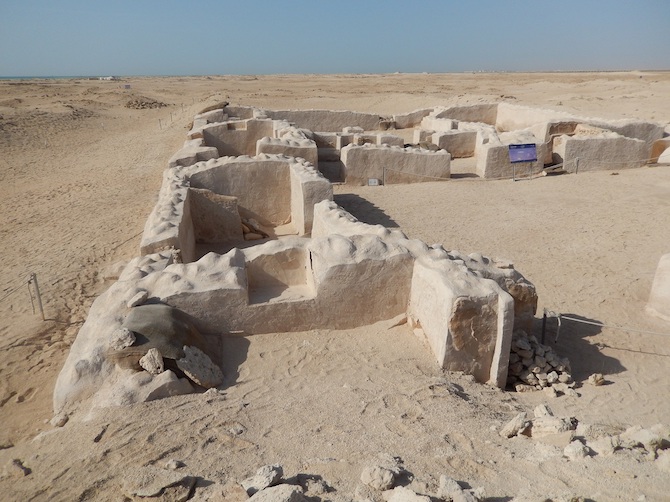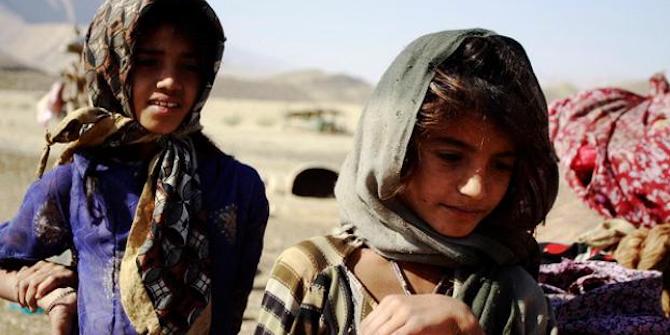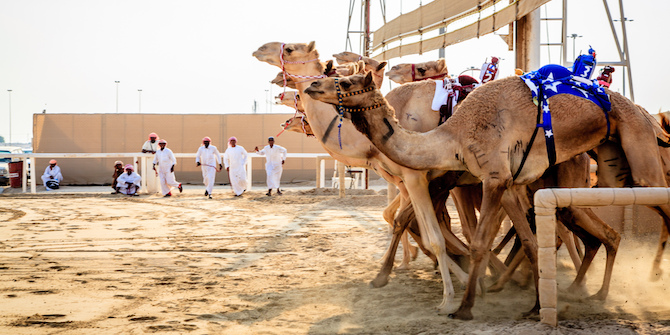by Robert Carter

There is a keen interest in heritage, history and archaeology in the GCC region, despite occasional claims to the contrary. Historical archaeology, particularly investigations covering the last two centuries, holds great potential for building on this interest, by widening community engagement in the area’s history and archaeological heritage, and underlining the connections between todays’ GCC nationals and excavated sites and finds in the region.
Because of the relatively recent advent of modernity brought by the coming of oil revenues, traditional lifestyles persisted well into living memory and direct experience of them remains today among the elderly and late middle-aged population of the region. The very rapid changes since the arrival of direct oil revenues are accompanied by anxiety that an irreparable break has been made with the past, leading to a perceived loss of heritage and of identity that threatens the well-being of today’s national societies. Conscious efforts to build national identity, based on selected qualities and activities of Gulf societies of the recent pre-oil past, are therefore widespread. In recent years such national identity politics have especially been expressed in the building of prestige museums. While acknowledging that the concept of national identity was alien to many individuals in the region prior to independence, such elements of heritage are not wholly imagined or constructed from nothing, but are rooted in the lived and living experience of the inhabitants of the region.
Historical archaeology bridges the gap between the past and present on a more personal level, and I argue that not only does this strengthen national identities, but also that it increases interest in heritage and archaeology. Its ability to connect historical facts, experiences and material culture with the lives and experiences of today’s national populations enables a direct personal relationship with archaeological discoveries. This concurs with local heritage concerns revolving around memory, family history and ancestry, expressed through oral histories and lineage lore held primarily within the immediate social group or family. For example, one recent project has seen living a former resident of a long-demolished village in Al-Ain (UAE) revisit his now excavated home with the archaeological team. In another case, excavations by the Origins of Doha and Qatar Project took place at a family home in Msheireb, Doha, which was repurposed as a museum of daily life, along with displays of its archaeological finds and excavated features (the Radwani House). In these cases the descendants of the residents, and in some cases the former residents themselves, were invited to share their lived experiences of the pre-oil and early oil past in order to enhance the research, allowing a more detailed understanding and presentation of the past, grounded in nationals’ experience as well as tangible archaeological finds.
Governmental initiatives have begun to take shape. In Muharraq, Bahrain, a new UNESCO World Heritage site was inscribed in 2012, Pearling: Testimony of an Island Economy, also known as the Bahrain Pearling Trail. This composite site was a serial nomination that included buildings related to pearl diving, including homes of merchants and divers, a music house, a coastal warehouse (‘amara) and the fort from which Muharraq’s annual pearling fleet was launched, as well as certain pearl oyster beds out at sea, at which visitors are permitted to dive in search of pearls. Two historic properties on the trail (the Fakhro ‘Amara and Bu Maher Fort) were excavated on behalf of Bahrain’s Ministry of Culture and Information (now the Bahrain Authority for Culture and Antiquities), along with other areas that revealed an unsuspected early Islamic occupation of Muharraq. Visitor resources are still under development of the trail, but already include excavated structures at the ‘Amara and at Bu Maher Fort, which are expected to be joined by excavated finds as well as other objects relating to the pearl fishery. On this heritage trail archaeological finds are therefore combined with architectural features, local testimony of pearl fishing in the pre-oil past, and formal historical data, intended to be experienced by the visitors as they walk through selected sections of the old town.
In another project, also mentioned above, The Origins of Doha and Qatar (funded by the Qatar National Research Fund), historical archaeology was accompanied by the collection of new and archival oral histories relating to former life in the Qatari towns, historical geography, GIS analyses of urban plan and architectural recording. The first phase involved joint excavations with Qatar Museums in the centre of Doha itself, as well as archaeological investigations of the Radwani House (above) and other significant historical locations (well sites, agricultural areas). Finds from the joint excavations are now on display at the recently-opened National Museum of Qatar.
During the second stage (2016–19) investigations took place at Fuwairit, a historic pearl-fishing town in the north of Qatar which was abandoned in the early twentieth century following the collapse of the regional pearl industry. Here it was possible to relate its archaeological history of occupation with historical accounts of abandonment and resettlement. This includes living testimony from members of a leading family of the former town (the Al Tuwar), who are still resident in a small village that sprang up near the abandoned site, albeit now mainly visiting only at weekends. Strong personal attachments to the old site and newer village remain, and historical awareness is maintained through oral transmission in the majlis. I was warmly welcomed by the family, who shared their historical knowledge and significantly enriched my understanding of the history of the site, adding an experiential and human dimension to the archaeological research. Events and personalities dating back more than a century are still remembered and discussed, complementing historical data known from formal archives. At the same time, personal memories of life in the ‘new’ village of Fuwairit in the 1950s–1970s testify to the critical decades of transformation that took place after oil.
In all these cases historical archaeology functions as a bridge to genuine heritage landscapes that are in a constant state of construction with reference to the past. Historical archaeology and connected disciplines incorporate local perspectives on heritage, including direct family history, resulting in an illuminating discourse that cannot be derived from material culture and archival records alone.
This is part of a series emerging from a workshop on ‘Heritage and National Identity Construction in the Gulf’ held at LSE on 5–6 December 2019. Read the introduction here, and see the other pieces below.
In this series:
- Introduction by Courtney Freer
- Souvenir Sovereignty in Qatar by Suzi Mirgani
- Examining Kuwait National Museum by Sundus Alrashid
- Urban Planning and its Legacy in Kuwait by Alexandra Gomes
- Museums as Political Institutions of National Identity Reproduction: Are Gulf States an Exception? by İdil Akıncı
- The New Populist Nationalism in Saudi Arabia: Imagined Utopia by Royal Decree by Madawi Al-Rasheed
- Heritage and Sectarianism in Bahrain by Thomas Fibiger
- Dubai Expo 2020 and Ancient Mercantile Heritage by Robert Mogielnicki
- Managing UNESCO World Heritage Sites in Saudi Arabia: Contribution and Future Directions by Abdulelah Al-Tokhais
- Finding Mariam: The Invisible Woman in Kuwait’s National Heritage Mythology by Alanoud Al-Sharekh
- Cultural Attendance: Attracting the Crowds to Museums in Saudi Arabia by Maha al-Senan
- Religion and Heritage in the Gulf: Significant in its Absence? by Courtney Freer
- Militarised Nationalism in the Gulf Monarchies: Crafting the Heritage of Tomorrow by Eleonora Ardemagni
- The Practice of Heritage in the Northern United Arab Emirates by Matthew MacLean
- Displaying the Nation in Museum Exhibitions in Qatar by Alexandra Bounia
- Implicit and Explicit Cultural Policies in Qatar: Contemporary Art Production and Censorship by Serena Iervolino
- The UAE State ‘Rebirthing’ of Motherhood: Who is birthing who? by Rima Sabban







1 Comments